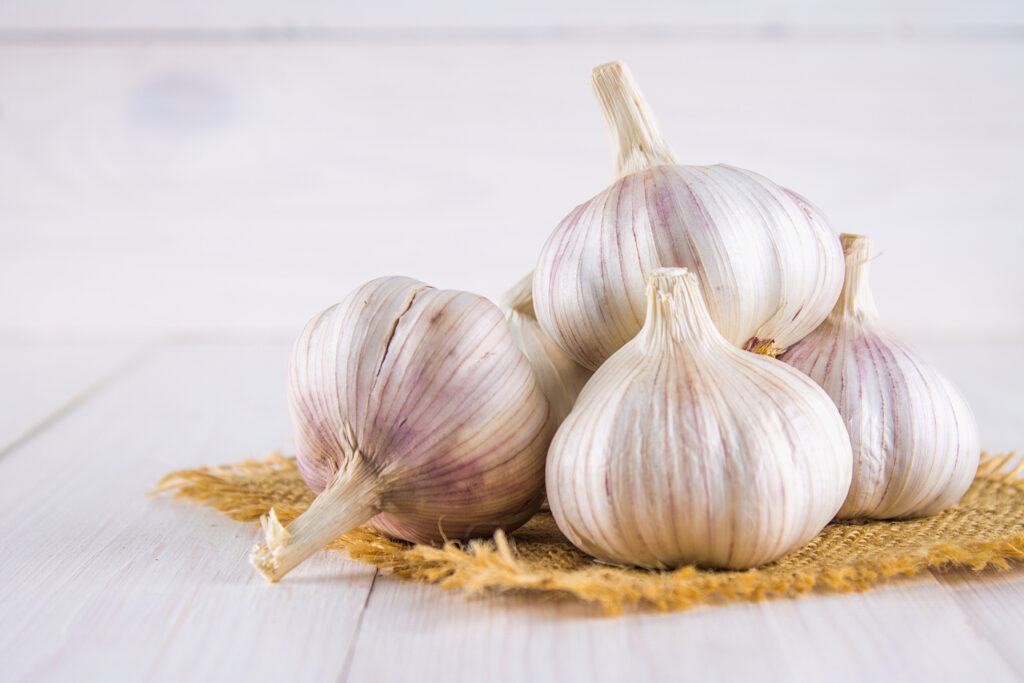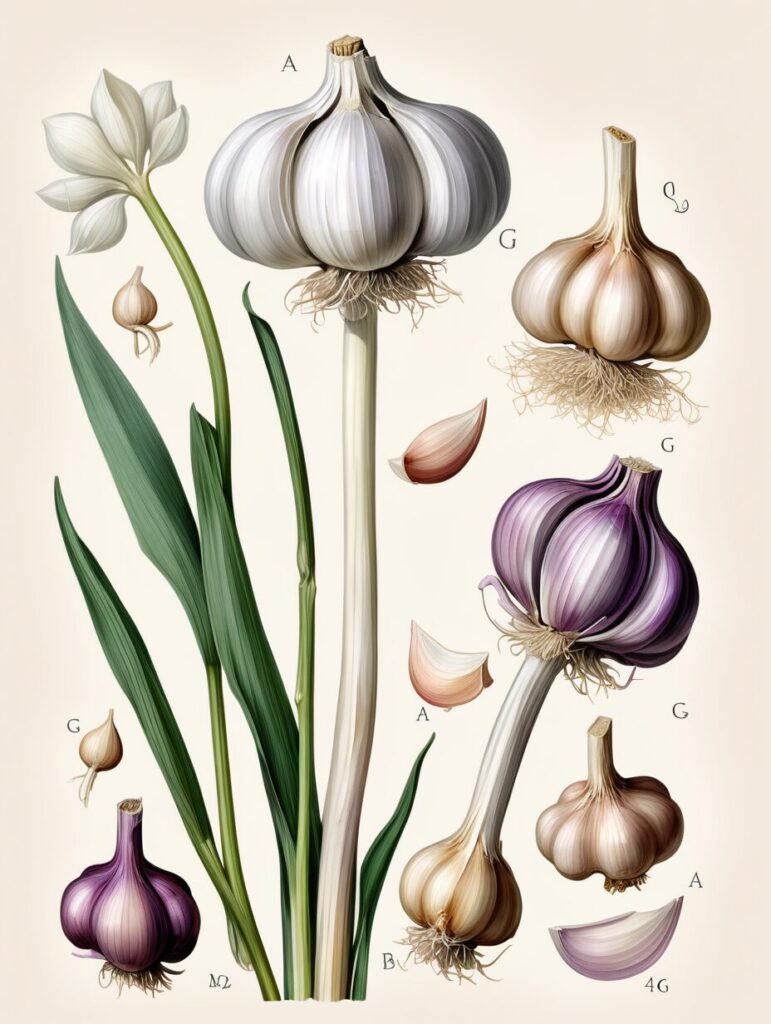Garlic, often referred to as the “stinking rose,” is a remarkable plant with a rich history and an array of uses that stretch far beyond its familiar kitchen presence. Much like a bridge between ancient remedies and modern medicine, garlic has etched its mark on cultures worldwide as a culinary delight and as a potent medicinal marvel. Its pungent aroma and robust flavor not only transform culinary dishes but also speak volumes of its revered therapeutic virtues.
From the depths of ancient folklore to the cutting-edge analyses of today, garlic’s undeniable influence spans centuries, each era revealing more about the depth of its attributes, making it an indispensable treasure in both the kitchen and pharmacy alike.



If garlic could be given a constitutional remedy in homeopathic terms, it would exemplify Sulphur. This comparison is not just about its sulfurous scent which fans of homeopathy associate with individuals of a particular constitutional type but delves into the broader therapeutic spectrum—that of protection, warmth, and dynamic energy. Its distinct flavor, sharp, spicy, and earthy, resonates deeply with its protective and healing nature. The garlicky breath is often a sign—one might say a calling card—for those with a Sulphur constitution, hinting at an underlying synergy between personality and this formidable bulb.
One of garlic’s most celebrated attributes lies in its effect on various organisms, notably its pest-repellent qualities. Insects find its odor profoundly off-putting, which makes garlic an invaluable ally in organic gardening. By using garlic-infused sprays or simply planting garlic alongside other crops, gardeners can protect their plants from unwelcome visitors while simultaneously promoting biodiversity. This dual role highlights garlic’s importance in sustainable agriculture, showcasing its potential to harmoniously coexist within natural cycles. Beyond its pest-repelling properties, garlic scapes—the curly tendrils that early on emerge before flowering—offer their culinary delight. Their mild, slightly sweet flavor is a favorite among chefs, who incorporate them into stir-fries, soups, and pestos, making them versatile components that underscore garlic’s culinary diversity.
The act of harvesting and braiding garlic reflects a timeless tradition that speaks to the interconnectedness of nature and human ingenuity. Selecting the largest and most flawless bulbs to weave into sturdy braids is not only a functional way to preserve the harvest but also a meditative practice of gratitude and craftsmanship. As these braids hang and dry, their aroma mellows and their flavors intensify, ready to imbue any dish with their essence. Each bulb becomes a symbol of nature’s bounty, a tangible reminder of the season and the promise it holds, sustaining us through colder months and connecting us with the earth and its cycles.
Garlic’s storied journey as a medicinal powerhouse originates from its rich composition of sulfur-containing compounds, the most notable being allicin. Formed when garlic is chopped or crushed, allicin emerges as a potent antimicrobial agent that disrupts bacterial cell membranes, efficiently neutralizing threats. This property makes garlic an effective natural remedy against a wide range of pathogens, such as Staphylococcus aureus, Escherichia coli, and Salmonella. Additionally, garlic’s antioxidant capabilities, attributed to compounds like S-allyl cysteine, play a pivotal role in neutralizing free radicals, thereby protecting cells from oxidative stress and inflammation—key factors in chronic diseases.
Garlic’s anti-inflammatory properties stem from its ability to impede the production of pro-inflammatory cytokines like TNF-α. By reducing inflammation, garlic supports the body in combating conditions such as arthritis and inflammatory bowel disease. Its sulfur compounds also display anticancer properties, inducing apoptosis in cancer cells and stymieing tumor metastasis. These diverse capabilities solidify garlic’s place as a cornerstone in both preventive health and therapeutic strategies.
One of garlic’s standout functions is in cardiovascular health through its influence on blood pressure and cholesterol management. Allicin’s vasodilatory effect assists in relaxing the smooth muscles of blood vessels, promoting dilation, which improves circulation and reduces blood pressure. It directly engages with cholesterol pathways, interacting with both LDL and HDL forms. Allicin prevents the oxidation of LDL cholesterol, reducing the risk of atherosclerotic plaque formation—a major contributor to heart disease. By integrating garlic into daily diets, one can harness these benefits, with the pungent cloves acting as nature’s ally against cardiac ailments.
Traditionally, garlic is considered both tamasic and rajasic in Ayurveda. It is thought to invigorate Pitta while balancing Vata and Kapha due to its heating properties. This alignment reflects garlic’s capacity to stimulate metabolism and circulation, though it should be consumed in moderation to prevent overheating, particularly in individuals predisposed to a fiery constitution. It is appreciated in colder climates for its ability to invigorate vitality and its detoxifying potential, adding another layer of complexity to its healing narrative.
Garlic’s cultivation is as captivating as its uses. Thriving as a cool-season crop, garlic is resilient, capable of enduring fluctuating climates between 50-70°F. Gardeners typically plant garlic in the fall, ahead of the first frost. Ensuring ample sunlight and well-drained loamy soil enriched with microbe compost, they provide the ideal environment for garlic’s growth. The bulbs must be planted carefully—pointy side facing up—to maximize development. As plants mature, garlic scapes are trimmed to shift energy back into bulb formation, encouraging plump bulbs ripe for curing and storage.
The antifungal properties garlic brings to gardens add another dimension to its contributions. Its sulfur compounds act decisively to curb fungal growth, stacking another layer of defense against common threats to crops. However, its influences on soil biomes must be navigated mindfully; cultivating garlic where mycorrhizal fungi are desired may be counterproductive because its robust antimicrobial properties can disrupt these beneficial relationships. As a garden companion, garlic pairs seamlessly with a variety of plants such as tomatoes and carrots, although its competition with legumes illustrates the nuanced play between protection and disruption. This nuanced symbiosis demonstrates garlic’s influential role in ecosystems—boasting both supportive and inhibitory capacities depending on context and placement.
The microbial world is not exempt from garlic’s impact. Allicin’s interaction with harmful microbes highlights its formidable role as a botanical defender. It undermines the protective biofilms these bacteria create to thwart immune responses, neutralizing their strongholds. Beyond targeting harmful pathogens, garlic’s prebiotic fibers feed the friendly bacteria of the gut, fostering an environment conducive to health and resilience. By modulating the microbial balance, particularly in favor of Lactobacilli and Bifidobacteria, garlic supports digestive health and reinforces immune strength—a synergy vital to maintaining homeostasis and warding off disease.
From its culinary vibrancy to therapeutic versatility, garlic’s diverse benefits continue to unfold. The infusion of its essence into cuisines and medicine alike captures the spirit of human exploration and connection with nature’s bounty, nurturing a relationship that has thrived over millennia. While raw cloves and their allicin presence bear the hallmark of garlic’s reputation, black garlic offers a palate-friendly alternative. The Maillard reaction, responsible for its earthy, sweet transformation, retains potent health benefits, particularly its treasure of stable antioxidants like S-allylcysteine. These compounds soothe sensitive stomachs while preserving garlic’s core advantages—ensuring access to its health-promoting potential without dietary offense.
Recipes leveraging garlic’s multifaceted qualities weave threads of traditional wisdom through modern kitchens. A simple garlic oil infusion can alleviate hair loss concerns, while foot baths explore its detoxifying potential. The grounding effect of garlic’s sulfur presence, when used in nail hardeners or joint pain relief balms, illustrates its comprehensive value beyond mere flavor enhancement. These applications nod to both the healing and transformative power of garlic, enveloping users in its protective embrace. As both a culinary cornerstone and folk remedy, garlic stands as an immortal gem—pungent, potent, and persistently indispensable. Within its cloves lie stories of connection, wisdom, and life’s ever-turning cycle; a reminder of nature’s abundant gifts and the profound harmony they cultivate across time and culture.
Garlic Nail Strengthener
Crush a clove of garlic and blend it into clear nail polish. Allow the mixture to rest for about a week before applying it as a treatment to fortify your nails. The sulfur compounds in garlic aid keratin production, helping to strengthen and toughen nails.
Garlic Detox Foot Soak
Simmer several cloves of garlic in a large pot of water. Let the water cool to a comfortable temperature, then immerse your feet for 20-30 minutes. This foot soak is believed to help remove toxins and alleviate foot odor due to garlic’s antimicrobial properties.
Garlic-Infused Hair Oil
Thinly slice garlic and infuse it in castor or coconut oil, storing the mixture in a cool, dark place for a few weeks. Apply the strained oil to the scalp, massaging it in and leaving it on for a while before rinsing. The abundant sulfur content in garlic helps reduce hair loss and supports scalp health.
Garlic and Turmeric Joint Relief Paste
Blend garlic cloves into a smooth paste and mix with turmeric powder and coconut oil to create a thick consistency. Apply this paste to sore joints and cover with a cloth, leaving it on for a few hours or overnight for optimal relief.




